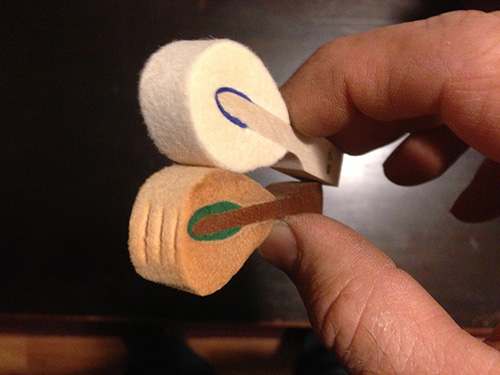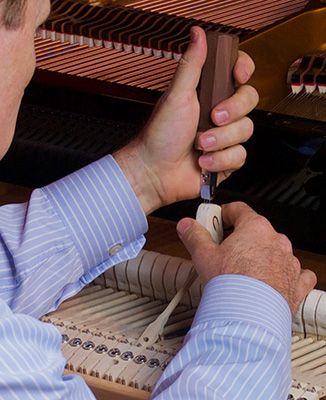regulation & voicing
Regulation
After several years of playing, the felt and cloth parts in a piano will wear down or compress from normal usage. Parts become out of alignment, loose or wobbly, and because of this, the touch of the piano may become inconsistent from key to key. It may feel sloppy, not as responsive as it used to, or no longer as comfortable to play. Other signs are excessive noises such as clicking and squeaking sounds.
The remedy for this is called regulation. The technician will clean and lubricate the action parts. He will also tighten, and align and all the parts to original specifications to optimize repetition and responsiveness.
The amount the piano is played and the ability and sensitivity of the pianist will dictate how often this procedure is needed.
A poorly regulated piano can severely hamper and frustrate a beginner as well as an advanced player, and the player will be amazed at how a little regulation can breathe new life and enjoyment into a piano's touch.
Voicing
Voicing means changing the tone of the piano by sanding, needling or applying chemicals to the felt of the hammers. There are three reasons for voicing:
1. After several years of playing the felt on the hammers will wear down, and grooves will form on them from striking the strings. When the grooves become too deep, the resilient shape of the hammers is lost and the tone becomes less pleasing. This happens so gradually, that the pianist will probably hardly notice the change.
New versus grooved, worn down hammers. Notice how little felt is left over the wood moulding.
To remedy this, the technician will sand the hammers to the original shape and remove the grooves. This process can dramatically enhance the tone, restoring it to its former richness.
2. Another aspect of voicing involves making the tone of the entire piano brighter or more mellow. Making it brighter is done, either by ironing or fine sanding the hammers, or by applying a chemical felt hardener. Making it more mellow is usually done by sanding the hammers, or pricking the hammers with needles, which softens the felt.
3. Sometimes some individual notes stick out as too bright, or not bright enough compared to the rest. In this case some fine voicing is required, which involves sanding and needling, to even out the tone so that it is consistent throughout the piano.
Whereas voicing can sometimes make large changes in the quality of the tone, it should be kept in mind that only so much can be done, given the inherent nature and tone of each individual piano.
When voicing a piano, the technician will probably want the pianist nearby to listen and tell him which type of tone they prefer.




